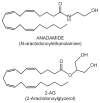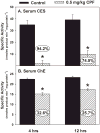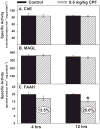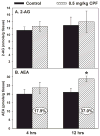Low level chlorpyrifos exposure increases anandamide accumulation in juvenile rat brain in the absence of brain cholinesterase inhibition
- PMID: 24373905
- PMCID: PMC4071163
- DOI: 10.1016/j.neuro.2013.12.009
Low level chlorpyrifos exposure increases anandamide accumulation in juvenile rat brain in the absence of brain cholinesterase inhibition
Abstract
The prevailing dogma is that chlorpyrifos (CPF) mediates its toxicity through inhibition of cholinesterase (ChE). However, in recent years, the toxicological effects of developmental CPF exposure have been attributed to an unknown non-cholinergic mechanism of action. We hypothesize that the endocannabinoid system may be an important target because of its vital role in nervous system development. We have previously reported that repeated exposure to CPF results in greater inhibition of fatty acid amide hydrolase (FAAH), the enzyme that metabolizes the endocannabinoid anandamide (AEA), than inhibition of either forebrain ChE or monoacylglycerol lipase (MAGL), the enzyme that metabolizes the endocannabinoid 2-arachidonylglycerol (2-AG). This exposure resulted in the accumulation of 2-AG and AEA in the forebrain of juvenile rats; however, even at the lowest dosage level used (1.0mg/kg), forebrain ChE inhibition was still present. Thus, it is not clear if FAAH activity would be inhibited at dosage levels that do not inhibit ChE. To determine this, 10 day old rat pups were exposed daily for 7 days to either corn oil or 0.5mg/kg CPF by oral gavage. At 4 and 12h post-exposure on the last day of administration, the activities of serum ChE and carboxylesterase (CES) and forebrain ChE, MAGL, and FAAH were determined as well as the forebrain AEA and 2-AG levels. Significant inhibition of serum ChE and CES was present at both 4 and 12h. There was no significant inhibition of the activities of forebrain ChE or MAGL and no significant change in the amount of 2-AG at either time point. On the other hand, while no statistically significant effects were observed at 4h, FAAH activity was significantly inhibited at 12h resulting in a significant accumulation of AEA. Although it is not clear if this level of accumulation impacts brain maturation, this study demonstrates that developmental CPF exposure at a level that does not inhibit brain ChE can alter components of endocannabinoid signaling.
Keywords: Chlorpyrifos; Developmental neurotoxicity; Endocannabinoid; Organophosphorus.
Copyright © 2013 Elsevier Inc. All rights reserved.
Figures





Similar articles
-
Inhibition of Endocannabinoid-Metabolizing Enzymes in Peripheral Tissues Following Developmental Chlorpyrifos Exposure in Rats.Int J Toxicol. 2017 Sep/Oct;36(5):395-402. doi: 10.1177/1091581817725272. Epub 2017 Aug 18. Int J Toxicol. 2017. PMID: 28820005 Free PMC article.
-
Decreased anxiety in juvenile rats following exposure to low levels of chlorpyrifos during development.Neurotoxicology. 2017 Mar;59:183-190. doi: 10.1016/j.neuro.2015.11.016. Epub 2015 Nov 28. Neurotoxicology. 2017. PMID: 26642910 Free PMC article.
-
Induction of endocannabinoid levels in juvenile rat brain following developmental chlorpyrifos exposure.Toxicol Sci. 2013 Sep;135(1):193-201. doi: 10.1093/toxsci/kft126. Epub 2013 Jun 12. Toxicol Sci. 2013. PMID: 23761300 Free PMC article.
-
Chlorpyrifos and Δ9 Tetrahydrocannabinol exposure and effects on parameters associated with the endocannabinoid system and risk factors for obesity.Curr Res Toxicol. 2021 Aug 8;2:296-308. doi: 10.1016/j.crtox.2021.08.002. eCollection 2021. Curr Res Toxicol. 2021. PMID: 34467221 Free PMC article. Review.
-
Enzyme ChE, cholinergic therapy and molecular docking: Significant considerations and future perspectives.Int J Immunopathol Pharmacol. 2024 Jan-Dec;38:3946320241289013. doi: 10.1177/03946320241289013. Int J Immunopathol Pharmacol. 2024. PMID: 39367568 Free PMC article. Review.
Cited by
-
Differences in neurotoxic outcomes of organophosphorus pesticides revealed via multi-dimensional screening in adult and regenerating planarians.Front Toxicol. 2022 Oct 4;4:948455. doi: 10.3389/ftox.2022.948455. eCollection 2022. Front Toxicol. 2022. PMID: 36267428 Free PMC article.
-
Inhibition of Endocannabinoid-Metabolizing Enzymes in Peripheral Tissues Following Developmental Chlorpyrifos Exposure in Rats.Int J Toxicol. 2017 Sep/Oct;36(5):395-402. doi: 10.1177/1091581817725272. Epub 2017 Aug 18. Int J Toxicol. 2017. PMID: 28820005 Free PMC article.
-
Gestational exposures to organophosphorus insecticides: From acute poisoning to developmental neurotoxicity.Neuropharmacology. 2020 Dec 1;180:108271. doi: 10.1016/j.neuropharm.2020.108271. Epub 2020 Aug 16. Neuropharmacology. 2020. PMID: 32814088 Free PMC article. Review.
-
Inhibition of cholinergic and non-cholinergic targets following subacute exposure to chlorpyrifos in normal and high fat fed male C57BL/6J mice.Food Chem Toxicol. 2018 Aug;118:821-829. doi: 10.1016/j.fct.2018.06.051. Epub 2018 Jun 21. Food Chem Toxicol. 2018. PMID: 29935250 Free PMC article.
-
Postnatal ethanol exposure alters levels of 2-arachidonylglycerol-metabolizing enzymes and pharmacological inhibition of monoacylglycerol lipase does not cause neurodegeneration in neonatal mice.J Neurochem. 2015 Jul;134(2):276-87. doi: 10.1111/jnc.13120. Epub 2015 Apr 30. J Neurochem. 2015. PMID: 25857698 Free PMC article.
References
-
- Aldridge JE, Seidler FJ, Slotkin TA. Developmental exposure to chlorpyrifos elicits sex-selective alterations of serotonergic synaptic function in adulthood: critical periods and regional selectivity for effects on the serotonin transporter, receptor subtypes, and cell signaling. Environ Health Perspect. 2004;112:148–155. - PMC - PubMed
-
- Anavi-Goffer S, Mulder J. The polarized life of the endocannabinoid system in CNS development. Chem Bio Chem. 2009;10:1591–1598. - PubMed
-
- Andersen SL. Trajectories of brain development: Point of vulnerability or window of opportunity? Neurosci Biobehav Rev. 2003;27:3–18. - PubMed
Publication types
MeSH terms
Substances
Grants and funding
LinkOut - more resources
Full Text Sources
Other Literature Sources

